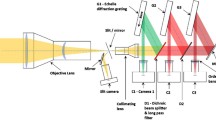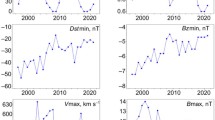Abstract
We present a multiwavelength analysis of a long-duration, white-light solar flare (M8.9/3B) event that occurred on 04 June 2007 from AR NOAA 10960. The flare was observed by several spaceborne instruments, namely SOHO/MDI, Hinode/SOT, TRACE, and STEREO/SECCHI. The flare was initiated near a small, positive-polarity, satellite sunspot at the center of the active region, surrounded by opposite-polarity field regions. MDI images of the active region show a considerable amount of changes in the small positive-polarity sunspot of δ configuration during the flare event. SOT/G-band (4305 Å) images of the sunspot also suggest the rapid evolution of this positive-polarity sunspot with highly twisted penumbral filaments before the flare event, which were oriented in a counterclockwise direction. It shows the change in orientation, and also the remarkable disappearance of twisted penumbral filaments (≈35 – 40%) and enhancement in umbral area (≈45 – 50%) during the decay phase of the flare. TRACE and SECCHI observations reveal the successive activation of two helically-twisted structures associated with this sunspot, and the corresponding brightening in the chromosphere as observed by the time-sequence of SOT/Ca ii H line (3968 Å) images. The secondary, helically-twisted structure is found to be associated with the M8.9 flare event. The brightening starts six – seven minutes prior to the flare maximum with the appearance of a secondary, helically-twisted structure. The flare intensity maximizes as the secondary, helically-twisted structure moves away from the active region. This twisted flux tube, associated with the flare triggering, did not launch a CME. The location of the flare activity is found to coincide with the activation site of the helically-twisted structures. We conclude that the activation of successive helical twists (especially the second one) in the magnetic-flux tubes/ropes plays a crucial role in the energy build-up process and the triggering of the M-class solar flare without a coronal mass ejection (CME).
Similar content being viewed by others
References
Altschuler, M.D., Newkirk, G.: 1969, Magnetic fields and the structure of the solar corona. I: Methods of calculating coronal fields. Solar Phys. 9, 131 – 149. doi: 10.1007/BF00145734 .
Amari, T., Luciani, J.F., Mikic, Z., Linker, J.: 2000, A twisted flux rope model for coronal mass ejections and two-ribbon flares. Astrophys. J. Lett. 529, L49 – L52. doi: 10.1086/312444 .
Antiochos, S.K.: 1998, The magnetic topology of solar eruptions. Astrophys. J. Lett. 502, L181 – L184. doi: 10.1086/311507 .
Canfield, R.C., Hudson, H.S., McKenzie, D.E.: 1999, Sigmoidal morphology and eruptive solar activity. Geophys. Res. Lett. 26, 627 – 630. doi: 10.1029/1999GL900105 .
Fan, Y., Gibson, S.E.: 2003, The emergence of a twisted magnetic flux tube into a preexisting coronal arcade. Astrophys. J. Lett. 589, L105 – L108. doi: 10.1086/375834 .
Filippov, B.P., Den, O.G.: 2001, A critical height of quiescent prominences before eruption. J. Geophys. Res. 106, 25177 – 25184. doi: 10.1029/2000JA004002 .
Filippov, B., Koutchmy, S.: 2002, About the prominence heating mechanisms during its eruptive phase. Solar Phys. 208, 283 – 295.
Forbes, T.G., Priest, E.R.: 1995, Photospheric magnetic field evolution and eruptive flares. Astrophys. J. 446, 377 – 389. doi: 10.1086/175797 .
Gary, G.A., Moore, R.L.: 2004, Eruption of a multiple-turn helical magnetic flux tube in a large flare: evidence for external and internal reconnection that fits the breakout model of solar magnetic eruptions. Astrophys. J. 611, 545 – 556. doi: 10.1086/422132 .
Gerrard, C.L., Arber, T.D., Hood, A.W.: 2002, The triggering of MHD instabilities through photospheric footpoint motions. Astron. Astrophys. 387, 687 – 699. doi: 10.1051/0004-6361:20020491 .
Gissot, S.F., Hochedez, J., Chainais, P., Antoine, J.: 2008, 3D reconstruction from SECCHI-EUVI images using an optical-flow algorithm: method description and observation of an erupting filament. Solar Phys. 252, 397 – 408. doi: 10.1007/s11207-008-9270-0 .
Ishii, T.T., Kurokawa, H., Takeuchi, T.T.: 1998, Emergence of a twisted magnetic flux bundle as a source of strong flare activity. Astrophys. J. 499, 898 – 904. doi: 10.1086/305669 .
Ishii, T.T., Kurokawa, H., Takeuchi, T.T.: 2000, Emergence of twisted magnetic-flux bundles and flare activity in a large active region, NOAA 4201. Publ. Astron. Soc. Japan 52, 337 – 354.
Ji, H., Wang, H., Schmahl, E.J., Moon, Y., Jiang, Y.: 2003, Observations of the failed eruption of a filament. Astrophys. J. Lett. 595, L135 – L138. doi: 10.1086/378178 .
Kliem, B., Titov, V.S., Török, T.: 2004, Formation of current sheets and sigmoidal structure by the kink instability of a magnetic loop. Astron. Astrophys. 413, L23 – L26. doi: 10.1051/0004-6361:20031690 .
Krall, J., Chen, J., Duffin, R.T., Howard, R.A., Thompson, B.J.: 2001, Erupting solar magnetic flux ropes: theory and observation. Astrophys. J. 562, 1045 – 1057. doi: 10.1086/323844 .
Kumar, P., Manoharan, P.K., Uddin, W.: 2010, Evolution of solar magnetic field and associated multi-wavelength phenomena: flare events on 20 November 2003. Astrophys. J. 710, 1195 – 1204. doi: 10.1088/0004-637X/710/2/1195 .
Liewer, P.C., de Jong, E.M., Hall, J.R., Howard, R.A., Thompson, W.T., Culhane, J.L., Bone, L., van Driel-Gesztelyi, L.: 2009, Stereoscopic analysis of the 19 May 2007 erupting filament. Solar Phys. 256, 57 – 72. doi: 10.1007/s11207-009-9363-4 .
Lin, J., Forbes, T.G.: 2000, Effects of reconnection on the coronal mass ejection process. J. Geophys. Res. 105, 2375 – 2392. doi: 10.1029/1999JA900477 .
Liu, R., Alexander, D.: 2009, Hard X-ray emission in kinking filaments. Astrophys. J. 697, 999 – 1009. doi: 10.1088/0004-637X/697/2/999 .
Liu, Y., Jiang, Y., Ji, H., Zhang, H., Wang, H.: 2003, Observational evidence of a magnetic flux rope eruption associated with the X3 flare on 2002 July 15. Astrophys. J. Lett. 593, L137 – L140. doi: 10.1086/378284 .
Liu, C., Deng, N., Liu, Y., Falconer, D., Goode, P.R., Denker, C., Wang, H.: 2005, Rapid change of δ spot structure associated with seven major flares. Astrophys. J. 622, 722 – 736. doi: 10.1086/427868 .
Min, S., Chae, J.: 2009, The rotating sunspot in AR 10930. Solar Phys. 258, 203 – 217. doi: 10.1007/s11207-009-9425-7 .
Nandy, D.: 2008, Magnetic helicity, coronal heating and solar flaring activity: a review of the role of active region twist. In: Howe, R., Komm, R.W., Balasubramaniam, K.S., Petrie, G.J.D. (eds.) Subsurface and Atmospheric Influences on Solar Activity CS-383, Astron. Soc. Pac., San Francisco, 201 – 212.
Rust, D.M., LaBonte, B.J.: 2005, Observational evidence of the kink instability in solar filament eruptions and sigmoids. Astrophys. J. Lett. 622, L69 – L72. doi: 10.1086/429379 .
Schatten, K.H., Wilcox, J.M., Ness, N.F.: 1969, A model of interplanetary and coronal magnetic fields. Solar Phys. 6, 442 – 455. doi: 10.1007/BF00146478 .
Scherrer, P.H., Bogart, R.S., Bush, R.I., Hoeksema, J.T., Kosovichev, A.G., Schou, J., Rosenberg, W., Springer, L., Tarbell, T.D., Title, A., Wolfson, C.J., Zayer, I., MDI Engineering Team: 1995, The solar oscillations investigation – Michelson Doppler imager. Solar Phys. 162, 129 – 188. doi: 10.1007/BF00733429 .
Schmidt, H.U.: 1964, On the observable effects of magnetic energy storage and release connected with solar flares. In: Hess, W.N. (ed.) NASA Spec. Publ. 50, 107.
Srivastava, A.K., Zaqarashvili, T.V., Kumar, P., Khodachenko, M.L.: 2010, Observation of kink instability during small B5.0 solar flare on 2007 June 4. Astrophys. J. 715, 292 – 299. doi: 10.1088/0004-637X/715/1/292 .
Török, T., Kliem, B.: 2005, Confined and ejective eruptions of kink-unstable flux ropes. Astrophys. J. Lett. 630, L97 – L100. doi: 10.1086/462412 .
Török, T., Kliem, B., Titov, V.S.: 2004, Ideal kink instability of a magnetic loop equilibrium. Astron. Astrophys. 413, L27 – L30. doi: 10.1051/0004-6361:20031691 .
Tsuneta, S., Ichimoto, K., Katsukawa, Y., Nagata, S., Otsubo, M., Shimizu, T., Suematsu, Y., Nakagiri, M., Noguchi, M., Tarbell, T., Title, A., Shine, R., Rosenberg, W., Hoffmann, C., Jurcevich, B., Kushner, G., Levay, M., Lites, B., Elmore, D., Matsushita, T., Kawaguchi, N., Saito, H., Mikami, I., Hill, L.D., Owens, J.K.: 2008, The solar optical telescope for the Hinode mission: an overview. Solar Phys. 249, 167 – 196. doi: 10.1007/s11207-008-9174-z .
van Tend, W., Kuperus, M.: 1978, The development of coronal electric current systems in active regions and their relation to filaments and flares. Solar Phys. 59, 115 – 127. doi: 10.1007/BF00154935 .
Wang, H., Ji, H., Schmahl, E.J., Qiu, J., Liu, C., Deng, N.: 2002, Sudden disappearance of a small sunspot associated with the 2002 February 20 M2.4 flare. Astrophys. J. Lett. 580, L177 – L180. doi: 10.1086/345713 .
Wang, H., Liu, C., Qiu, J., Deng, N., Goode, P.R., Denker, C.: 2004, Rapid penumbral decay following three X-class solar flares. Astrophys. J. Lett. 601, L195 – L198. doi: 10.1086/382188 .
Williams, D.R., Török, T., Démoulin, P., van Driel-Gesztelyi, L., Kliem, B.: 2005, Eruption of a kink-unstable filament in NOAA active region 10696. Astrophys. J. Lett. 628, L163 – L166. doi: 10.1086/432910 .
Wuelser, J., Lemen, J.R., Tarbell, T.D., Wolfson, C.J., Cannon, J.C., Carpenter, B.A., Duncan, D.W., Gradwohl, G.S., Meyer, S.B., Moore, A.S., Navarro, R.L., Pearson, J.D., Rossi, G.R., Springer, L.A., Howard, R.A., Moses, J.D., Newmark, J.S., Delaboudiniere, J., Artzner, G.E., Auchere, F., Bougnet, M., Bouyries, P., Bridou, F., Clotaire, J., Colas, G., Delmotte, F., Jerome, A., Lamare, M., Mercier, R., Mullot, M., Ravet, M., Song, X., Bothmer, V., Deutsch, W.: 2004, EUVI: the STEREO-SECCHI extreme ultraviolet imager. In: Fineschi, S., Gummin, M.A. (eds.) SPIE CS-5170, 111 – 122. doi: 10.1117/12.506877 .
Yashiro, S., Gopalswamy, N., Akiyama, S.: 2008, Poor CME productivity in active region 10960. AGU Spring Meeting Abstracts, A3.
Author information
Authors and Affiliations
Corresponding author
Electronic Supplementary Material
Below are the links to the electronic supplementary material.
Rights and permissions
About this article
Cite this article
Kumar, P., Srivastava, A.K., Filippov, B. et al. Multiwavelength Study of the M8.9/3B Solar Flare from AR NOAA 10960. Sol Phys 266, 39–58 (2010). https://doi.org/10.1007/s11207-010-9586-4
Received:
Accepted:
Published:
Issue Date:
DOI: https://doi.org/10.1007/s11207-010-9586-4




